Abstract
1. A titration assay with two end points is described for comparison of the emetic and lethal potencies of digitalis-like drugs.
2. A drug was infused at constant rate to a conscious, unrestrained cat, through an indwelling venous cannula. At the moment of vomiting the cat was rapidly anaesthetized and infusion continued at the same rate until the moment of cardiac arrest.
3. With very slow and very fast infusions, the emetic and lethal doses tended to rise. In the range between these extremes (which varied from drug to drug) they were independent of time.
4. The observations could be accounted for by analogue computation, assuming that the drugs entered an initial pool and were distributed at finite rates to receptors in the CNS (vomiting centre) and heart.
5. Half times of metabolic loss derived from this computation for digitoxin, digoxin and ouabain (17, 9·9 and 1·8 h, respectively) were in the same ratio as the threefold longer half times reported for these drugs in man.
6. When measured with infusion rates in the time independent range, the ratio of lethal to emetic doses did not vary between the drugs studied. All caused vomiting at 40% of the lethal dose.
7. From a review of the literature, the emetic and cardiotoxic actions of digitalis-like drugs appear inseparable and probably share a common biochemical mechanism.
8. It is concluded that foreseeable improvements in digitalis-like drugs are small and would depend on the elimination of any local emetic effect on gut receptors which they may have.
Full text
PDF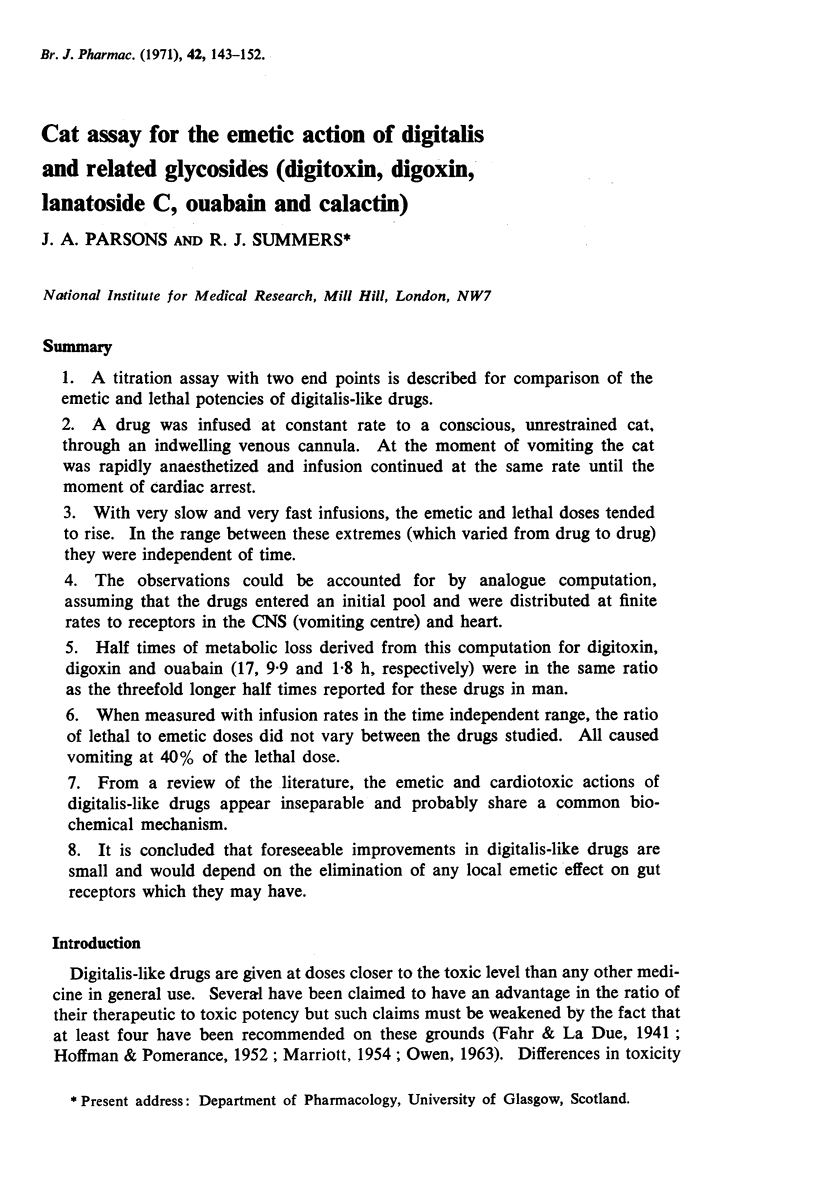
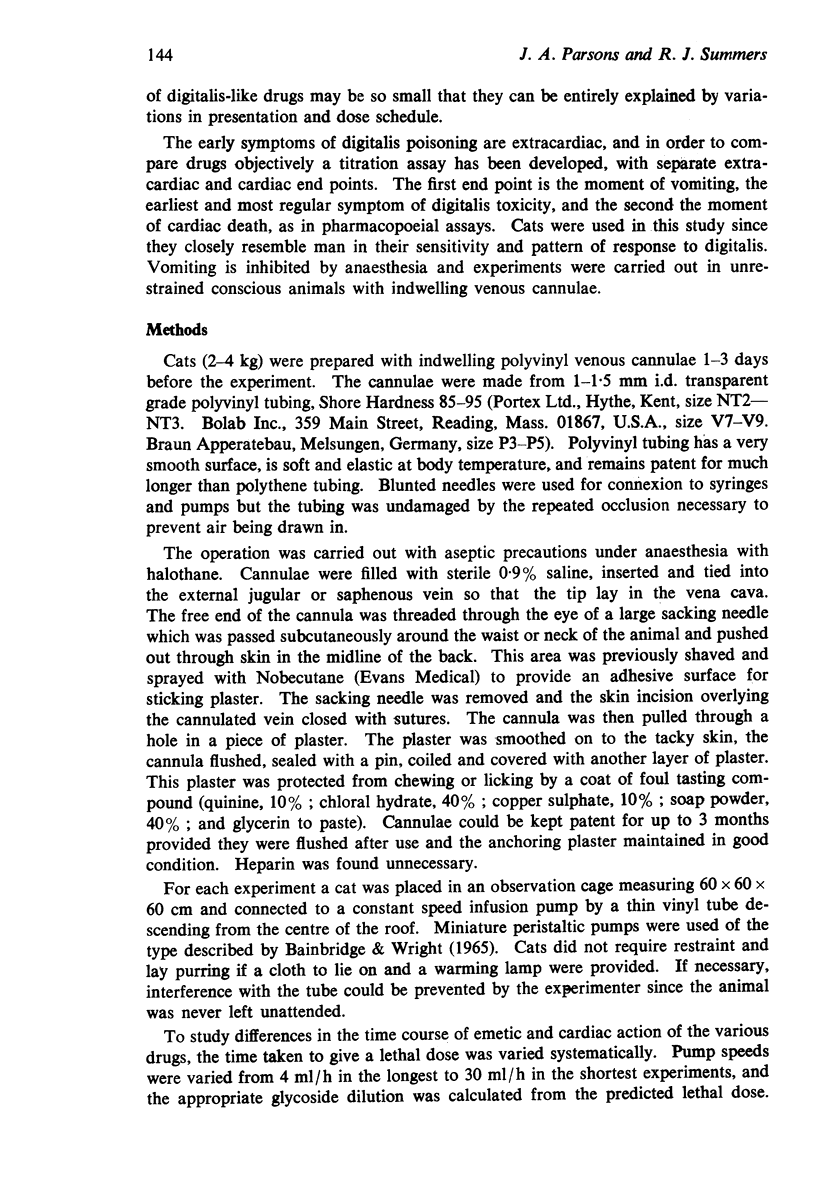
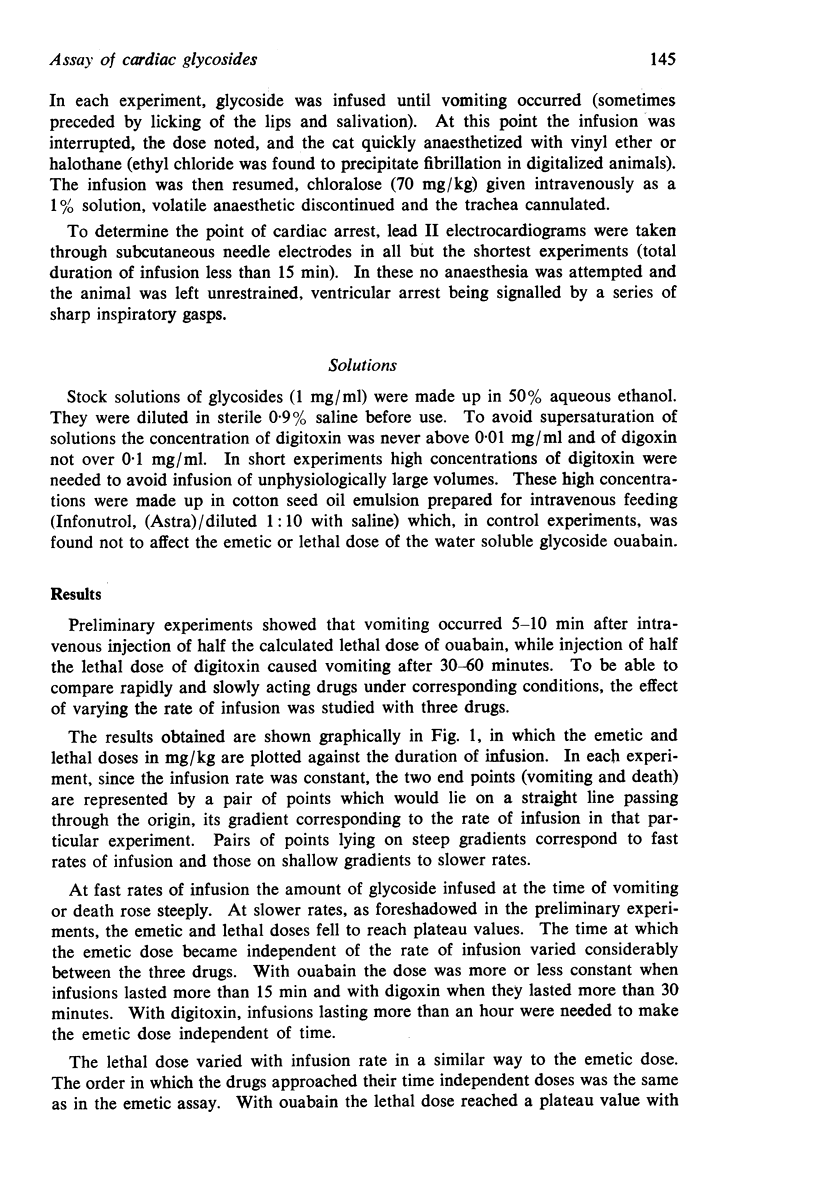
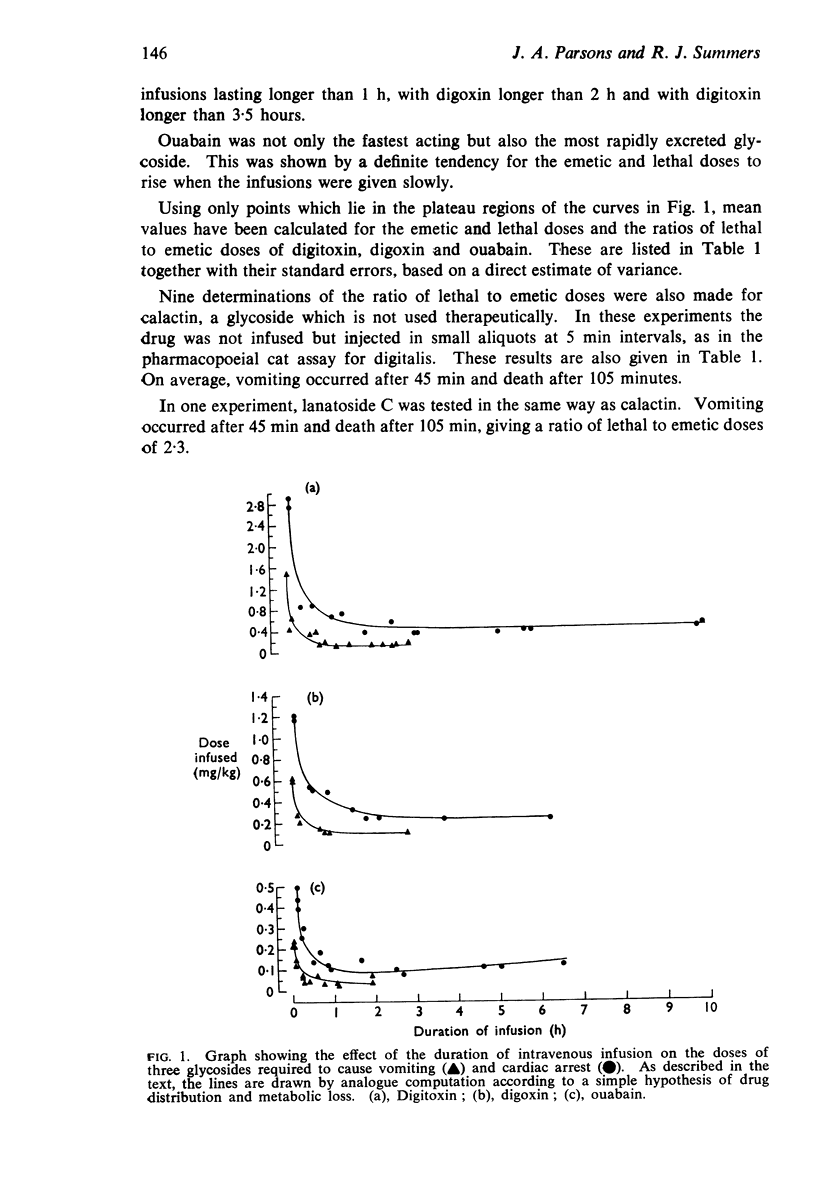
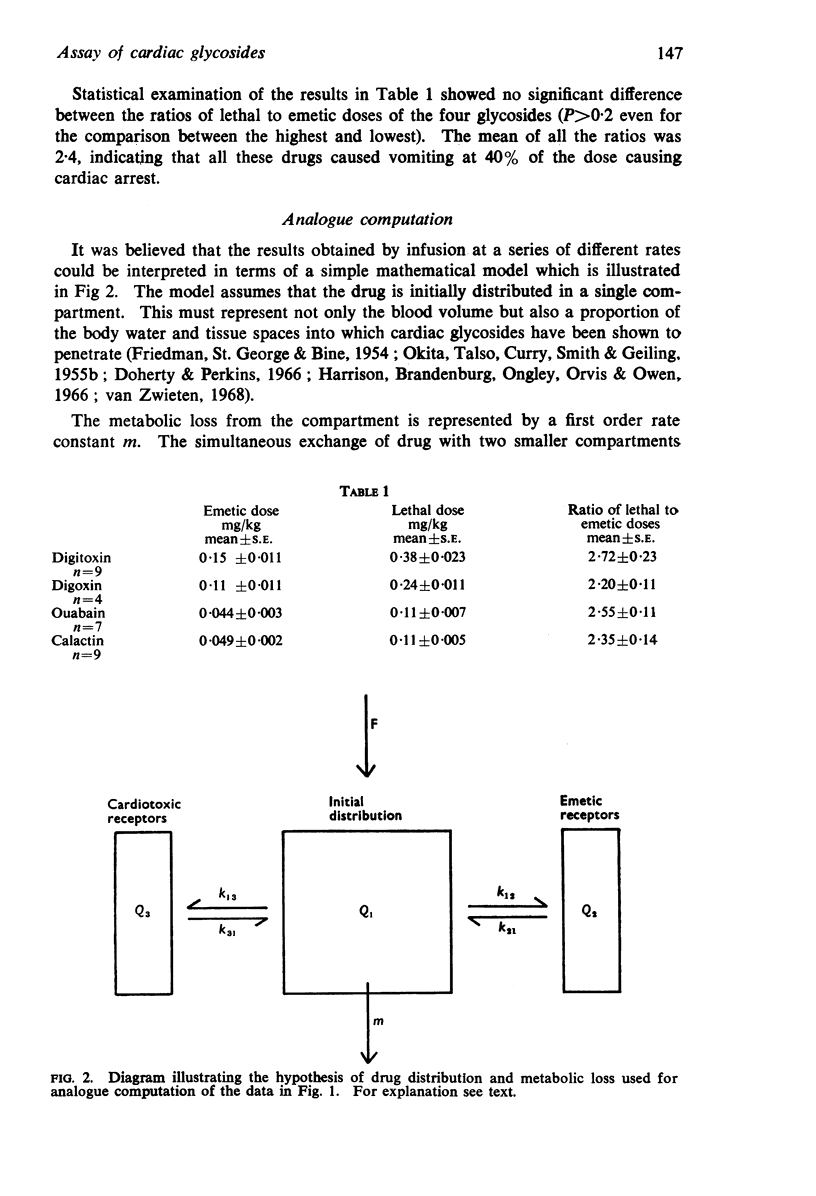
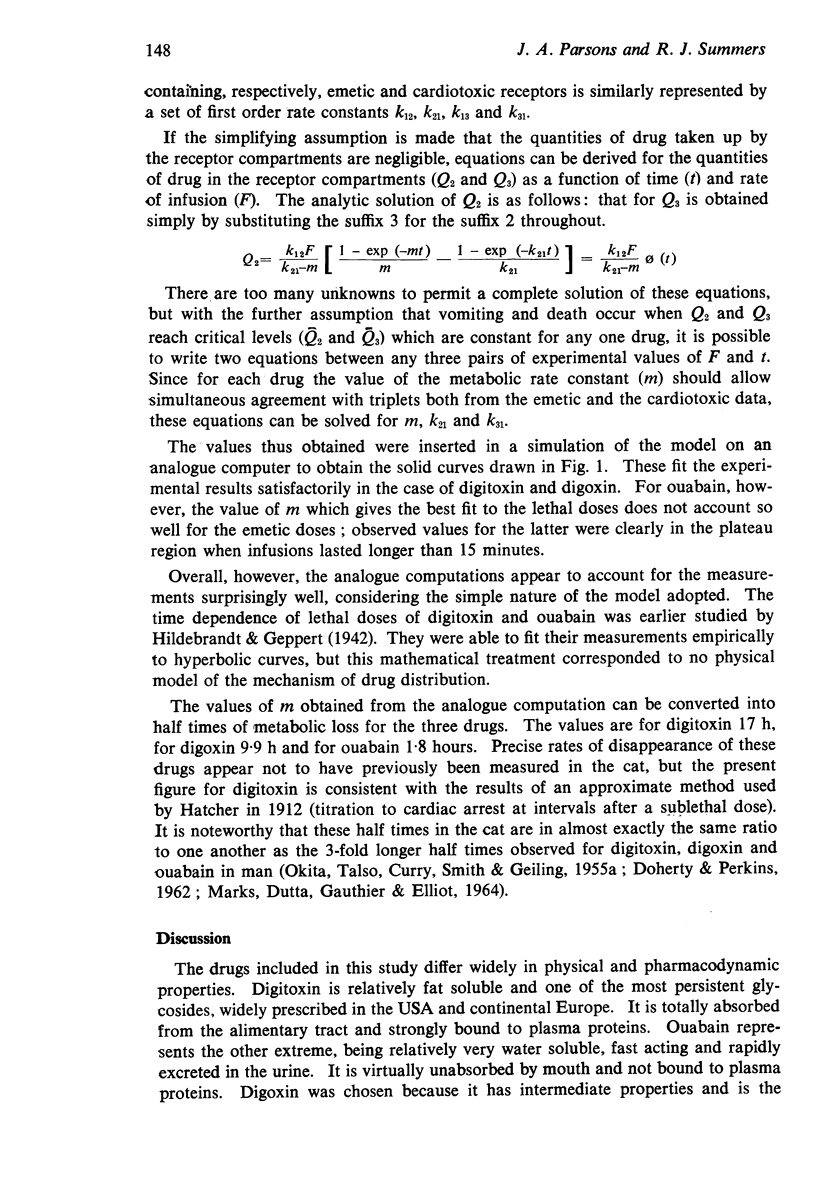
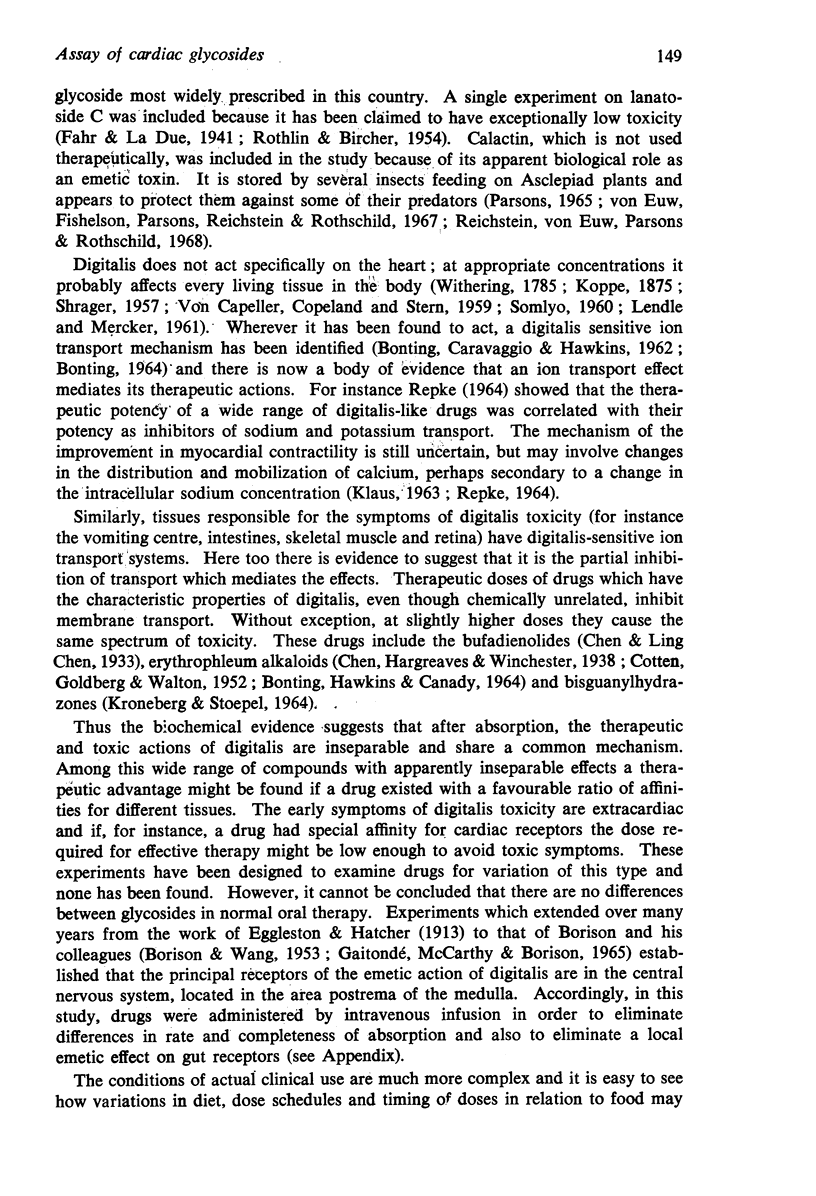
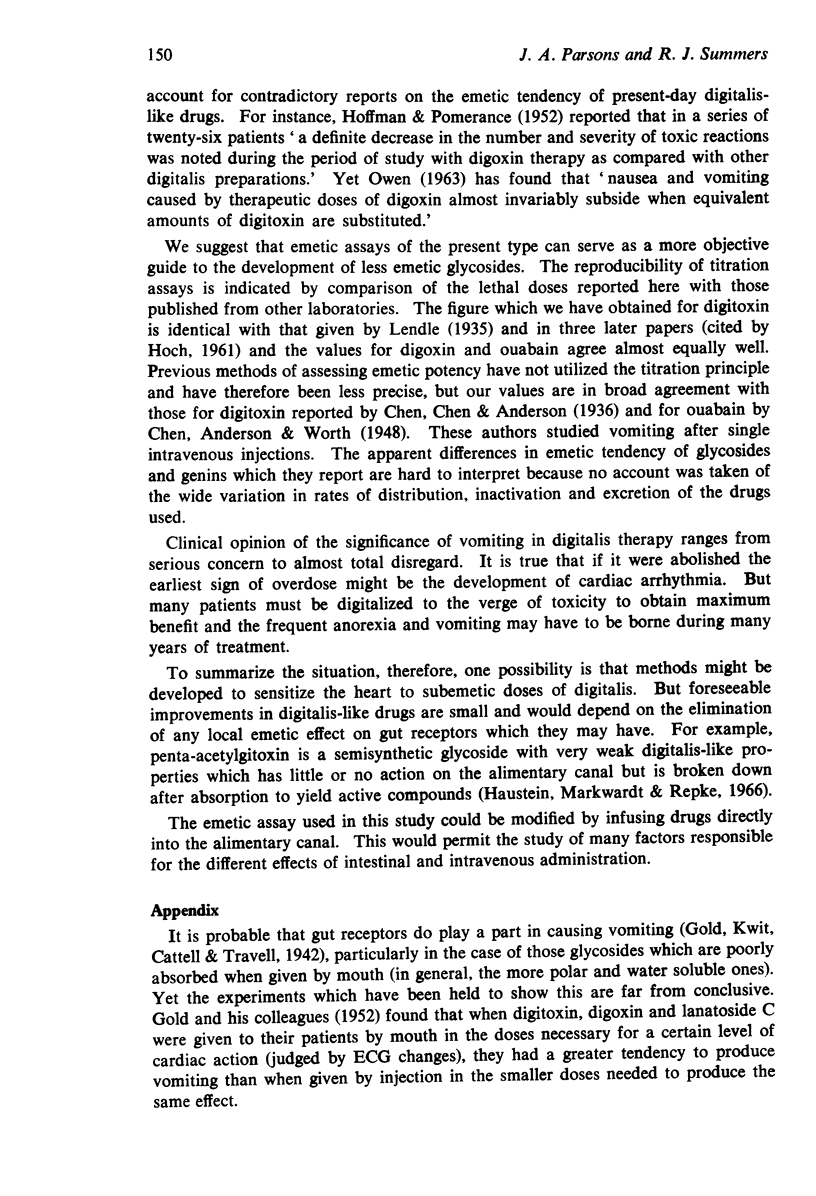
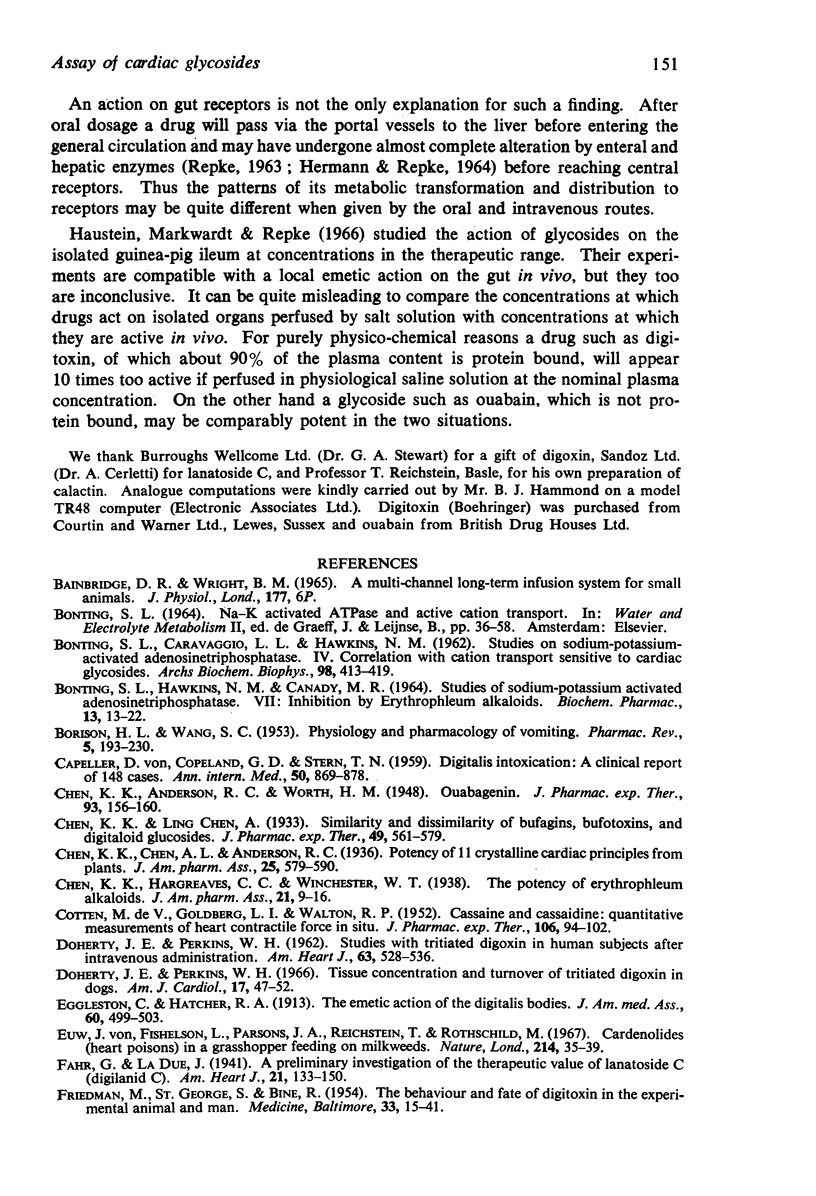
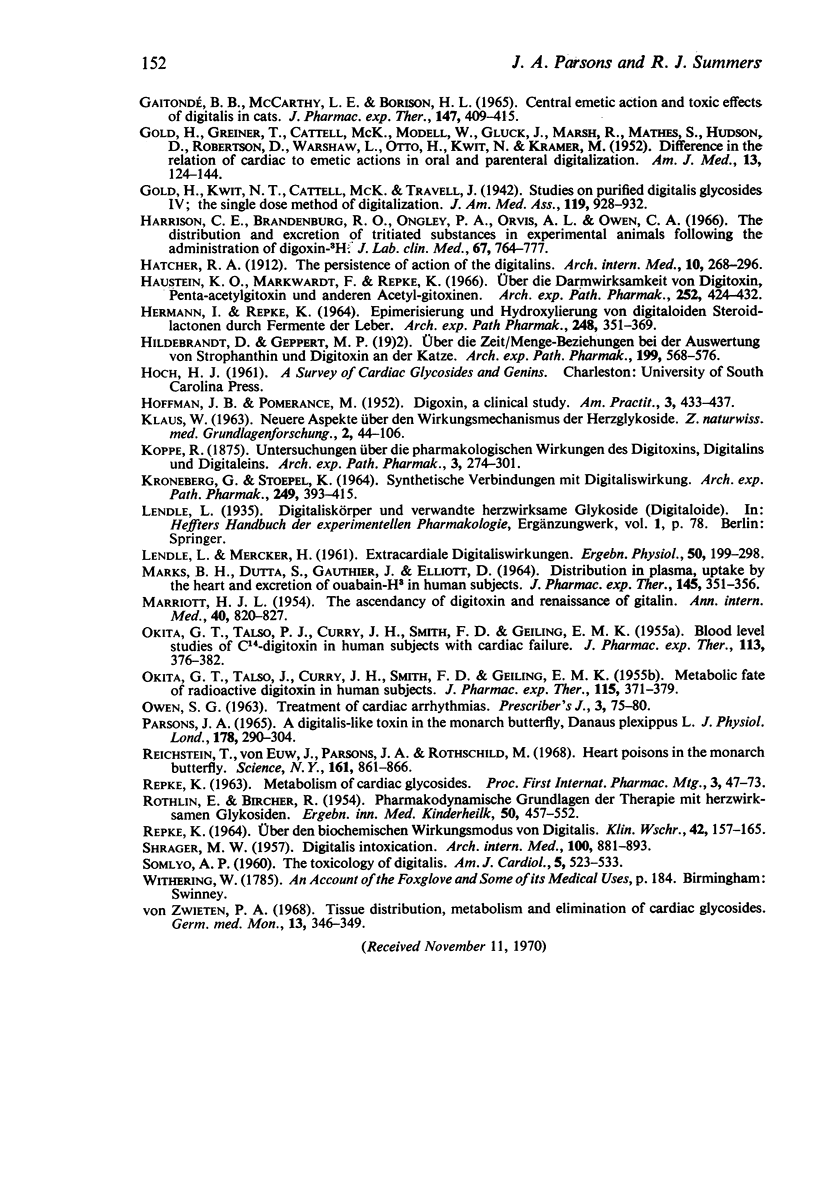
Selected References
These references are in PubMed. This may not be the complete list of references from this article.
- BONTING S. L., CARAVAGGIO L. L., HAWKINS N. M. Studies on sodium-potassium-activated adenosinetriphosphatase. IV. Correlation with cation transport sensitive to cardiac glycosides. Arch Biochem Biophys. 1962 Sep;98:413–419. doi: 10.1016/0003-9861(62)90206-0. [DOI] [PubMed] [Google Scholar]
- BONTING S. L., HAWKINS N. M., CANADY M. R. STUDIES OF SODIUM-POTASSIUM ACTIVATED ADENOSINE TRIPHOSPHATASE. VII. INHIBITATION BY ERYTHROPHLEUM ALKALOIDS. Biochem Pharmacol. 1964 Jan;13:13–22. doi: 10.1016/0006-2952(64)90074-7. [DOI] [PubMed] [Google Scholar]
- BORISON H. L., WANG S. C. Physiology and pharmacology of vomiting. Pharmacol Rev. 1953 Jun;5(2):193–230. [PubMed] [Google Scholar]
- COTTEN M. D., GOLDBERG L. I., WALTON R. P. Cassaine and cassaidine: quantitative measurements of heart contractile force in situ. J Pharmacol Exp Ther. 1952 Sep;106(1):94–102. [PubMed] [Google Scholar]
- DOHERTY J. E., PERKINS W. H. Studies with tritiated digoxin in human subjects after intravenous administration. Am Heart J. 1962 Apr;63:528–536. doi: 10.1016/0002-8703(62)90310-1. [DOI] [PubMed] [Google Scholar]
- Doherty J. E., Perkins W. H. Tissue concentration and turnover of tritiated digoxin in dogs. Am J Cardiol. 1966 Jan;17(1):47–52. doi: 10.1016/0002-9149(66)90259-1. [DOI] [PubMed] [Google Scholar]
- FRIEDMAN M., ST. GEORGE S., BINE R., Jr The behavior and fate of digitoxin in the experimental animal and man. Medicine (Baltimore) 1954 Feb;33(1):15–41. doi: 10.1097/00005792-195402000-00002. [DOI] [PubMed] [Google Scholar]
- GAITONDE B. B., MCCARTHY L. E., BORISON H. L. CENTRAL EMETIC ACTION AND TOXIC EFFECTS OF DIGITALIS IN CATS. J Pharmacol Exp Ther. 1965 Mar;147:409–415. [PubMed] [Google Scholar]
- GOLD H., GREINER T., CATTELL M., MODELL W., GLUCK J., MARSH R., MATHES S., HUDSON D., ROBERTSON D., WARSHAW L. Difference in the relation of cardiac to emetic actions in oral and parenteral digitalization. Am J Med. 1952 Aug;13(2):124–144. doi: 10.1016/0002-9343(52)90152-6. [DOI] [PubMed] [Google Scholar]
- HERRMANN I., REPKE K. EPIMERISIERUNG UND HYDROXYLIERUNG VON DIGITALOIDEN STEROIDLACTONEN DURCH FERMENTE DER LEBER. Naunyn Schmiedebergs Arch Exp Pathol Pharmakol. 1964 Jun 22;248:351–369. [PubMed] [Google Scholar]
- HOFFMAN J. B., POMERANCE M. Digoxin, a clinical study. Am Pract Dig Treat. 1952 Jun;3(6):433–437. [PubMed] [Google Scholar]
- Harrison C. E., Jr, Brandenburg R. O., Ongley P. A., Orvis A. L., Owen C. A., Jr The distribution and excretion of tritiated substances in experimental animals following the administration of digoxin-3H. J Lab Clin Med. 1966 May;67(5):764–777. [PubMed] [Google Scholar]
- Haustein K. O., Markwardt F., Repke K. Uber die Darmwirksamkeit von Digitoxin, Penta-acetyl-gitoxin und anderen Acetyl-gitoxinen. Naunyn Schmiedebergs Arch Exp Pathol Pharmakol. 1966;252(5):424–432. [PubMed] [Google Scholar]
- KRONEBERG G., STOEPEL K. SYNTHETISCHE VERBINDUNGEN MIT DIGITALISWIRKUNG. Naunyn Schmiedebergs Arch Exp Pathol Pharmakol. 1964 Nov 25;249:393–415. doi: 10.1007/BF00247046. [DOI] [PubMed] [Google Scholar]
- MARKS B. H., DUTTA S., GAUTHIER J., ELLIOTT D. DISTRIBUTION IN PLASMA, UPTAKE BY THE HEART AND EXCRETION OF OUABAIN-H3 IN HUMAN SUBJECTS. J Pharmacol Exp Ther. 1964 Sep;145:351–356. [PubMed] [Google Scholar]
- MARRIOTT H. J. The ascendancy of digitoxin and renaissance of gitalin. Ann Intern Med. 1954 Apr;40(4):820–827. doi: 10.7326/0003-4819-40-4-820. [DOI] [PubMed] [Google Scholar]
- OKITA G. T., TALSO P. J., CURRY J. H., Jr, SMITH F. D., Jr, GEILING E. M. Blood level studies of C14-digitoxin in human subjects with cardiac failure. J Pharmacol Exp Ther. 1955 Apr;113(4):376–382. [PubMed] [Google Scholar]
- OKITA G. T., TALSO P. J., CURRY J. H., Jr, SMITH F. D., Jr, GEILING E. M. Metabolic fate of radioactive digitoxin in human subjects. J Pharmacol Exp Ther. 1955 Dec;115(4):371–379. [PubMed] [Google Scholar]
- PARSONS J. A. A DIGITALIS-LIKE TOXIN IN THE MONARCH BUTTERFLY, DANAUS PLEXIPPUS L. J Physiol. 1965 May;178:290–304. doi: 10.1113/jphysiol.1965.sp007628. [DOI] [PMC free article] [PubMed] [Google Scholar]
- REPKE K. UBER DEN BIOCHEMISCHEN WIRKUNGSMODUS VON DIGITALIS. Klin Wochenschr. 1964 Feb 15;42:157–165. doi: 10.1007/BF01482616. [DOI] [PubMed] [Google Scholar]
- ROTHLIN E., BIRCHER R. Pharmakodynamische Grundlagen der Therapie mit herzwirksamen Glykosiden. Ergeb Inn Med Kinderheilkd. 1954;5:457–552. [PubMed] [Google Scholar]
- Reichstein T., von Euw J., Parsons J. A., Rothschild M. Heart poisons in the monarch butterfly. Some aposematic butterflies obtain protection from cardenolides present in their food plants. Science. 1968 Aug 30;161(3844):861–866. doi: 10.1126/science.161.3844.861. [DOI] [PubMed] [Google Scholar]
- SHRAGER M. W. Digitalis intoxication; a review and report of forty cases, with emphasis on etiology. AMA Arch Intern Med. 1957 Dec;100(6):881–893. doi: 10.1001/archinte.1957.00260120025004. [DOI] [PubMed] [Google Scholar]
- SOMLYO A. P. The toxicology of digitalis. Am J Cardiol. 1960 Apr;5:523–533. doi: 10.1016/0002-9149(60)90111-9. [DOI] [PubMed] [Google Scholar]
- VON CAPELLER D., COPELAND G. D., STERN T. N. Digitalis intoxication: a clinical report of 148 cases. Ann Intern Med. 1959 Apr;50(4):869–878. doi: 10.7326/0003-4819-50-4-869. [DOI] [PubMed] [Google Scholar]
- van Zwieten P. A. Tissue distribution, metabolism and elimination of cardiac glycosides. Ger Med Mon. 1968 Jul;13(7):346–349. [PubMed] [Google Scholar]
- von Euw J., Fishelson L., Parsons J. A., Reichstein T., Rothschild M. Cardenolides (heart poisons) in a grasshopper feeding on milkweeds. Nature. 1967 Apr 1;214(5083):35–39. doi: 10.1038/214035a0. [DOI] [PubMed] [Google Scholar]


